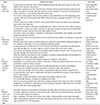Abstract
Objectives
The purpose of this study was to evaluate the effectiveness of team-based learning (TBL) method in clinical dental hygiene subjects to improve the competence of learners.
Methods
Clinical dental hygiene and practiceII was implemented and evaluated by utilizing a team-based learning module. Communication skills, self-directed learning ability, and learning attitude were measured over the course of the module
Figures and Tables
Table 1
Comparison before and after learning: communication ability, self-directed learning ability, learning attitude

References
1. Bae SM, Shin SJ, Jang JH, Chung WG, Shin BM. Analysis of current status of a dental hygiene science curriculum according to the dental hygienist competency. J Korean Soc Dent Hyg. 2016; 16:173–183.

2. Kang YJ. Analysis on the recognition of occupational work training in new dental hygienists. J Korean Soc Dent Hyg. 2007; 7:365–379.
3. Roh YS, Ryoo EN, Choi DW, Baek SS, Kim SS. A survey of student perceptions, academic achievement, and satisfaction of teambased learning in a nursing course. J Korean Acad Soc Nurs Educ. 2012; 18:239–247.

4. Lim JH, Ryu KH, Kim BC. An exploratory study on the direction of education and teacher competencies in the 4th industrial revolution. J Korean Educ. 2017; 44:5–32.
5. Kim EJ. A meta analysis of team based learning effects in university classes. JLCI. 2017; 17:721–743.

6. Ryu YM, Kim Hj. The comparison of effects of team-based learning and lecture-based learning in nursing students. JLCI. 2018; 18:49–66.

7. Kim SO. Effects of team-based learning on learning attitude, learning motivation, problem solving ability, participation in lessons of nursing students. J Digit Converg. 2017; 15:351–363.

8. Jun HS, Ju HJ. The effect of team based learning on communication ability, problem solving ability and self-directed learning in nursing science education. J Digit Converg. 2017; 15:269–279.
9. Lee YG. The effect of team-formation and collaborative learning style on college students' learning outcomes: an application of team-based learning model. Korean Educ Rev. 2016; 22:115–139.
10. Kim HM. Comparison of student evaluation methods in team based learning classes for dental hygiene students. J Korea Contents Assoc. 2018; 18:115–122.
11. Park IS, Kim DK. A study on dental hygiene students effects of team-based learning in the dental hygiene curriculum on learning motivation and self-directed learning capabilities. J Korean Soc Dent Hyg. 2010; 10:127–140.
12. Chae SJ, Hwang MY. An analysis of relationship between peer assessment results and self directed learning readiness in a team based learning objected on dental hygiene students. J Korean Soc Dent Hyg. 2009; 9:536–544.
13. Choi YK, Lim KO, Han YK, Bae SM, Shin BM, Ahn SY, et al. Study on clinical dental hygiene in Korea based on analysis of clinical dental hygiene curriculum of Fones School in the United States. J Dent Hyg Sci. 2017; 17:123–133.

14. Kim AN, Kim NH, Kim TJ, Lee SJ, Jung HO. Research on the national standards of life competencies and quality management for learning system(II). . Incheon: Korean Educational Development Institute;2003. p. 195–210.
15. Park IS. Effect of TBL (Team-Based Learning) on oral prophylaxis of dental hygiene students [dissertation]. Gwangju: Chosun University;2008. [Korean].
16. Parmelee D, Michaelsen LK, Cook S, Hudes PD. Team-based learning: a practical guide: AMEE guide no. 65. Med Teach. 2012; 34:e275–e287.

17. Kim SJ, Kim HH. Impact of communication competence and empathy abilities on interpersonal relationship abilities among dental hygiene students. J Dent Hyg Sci. 2013; 13:304–313.
18. Cho AR, Han SI, Yoon SH, Park JH, Yoo NJ, Kim S. Methods of effective team-based learning administration and expected effects on medical education. Korean J Med Educ. 2010; 22:47–55.


19. Takeuchi H, Omoto K, Okura K, Tajima T, Suzuki Y, Hosoki M, et al. Effects of team-based learning on fixed prosthodontic education in a Japanese School of Dentistry. J Dent Educ. 2015; 79:417–423.


20. Choi KO, Park YM. Effects of team-based learning on problem solving ability, critical thinking disposition and self-directed learning in undergraduate nursing students. J East-West Nurs Res. 2014; 20:154–159.

21. Lim SH. Effect of team-based learning on anatomy subject for biological nursing science education of nursing students. JKAIS. 2015; 16:7098–7108.

22. Park SE, Kim JH, Anderson N. Evaluating a team-based learning method for detecting dental caries in dental students. J Curr Teaching. 2014; 3:100–105.

23. Pileggi R, O’Neill PN. Team-based learning using an audience response system: an innovative method of teaching diagnosis to undergraduate dental students. J Dent Educ. 2008; 72:1182–1188.


24. Kim YJ, Lee SH, Yoo HH. Analysis of students' reflective journals on medical communication role plays. Korean Med Educ Rev. 2017; 19:169–174.

25. Tsang AKL. Oral health students as reflective practitioners: changing patterns of student clinical reflections over a period of 12 months. J Dent Hyg. 2012; 86:120–129.





 PDF
PDF ePub
ePub Citation
Citation Print
Print








 XML Download
XML Download